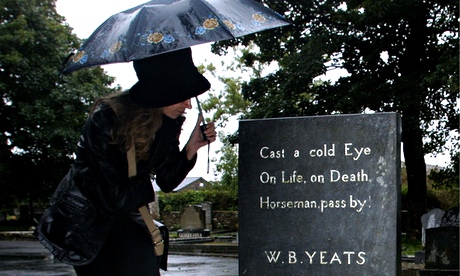
“Who rests under Ben Bulben?” asked the Irish Times’s front page last weekend, referencing WB Yeats’s poem eerily looking forward to his grave in a churchyard beneath a crag in Co Sligo. “Not Yeats,” was the paper’s blunt answer. “Papers confirm bones sent by French were not poet’s.” Yeats died in Roquebrune on the French Riviera in 1939, which prevented the return of his remains to Ireland and his widow until after the war. The letters recently unearthed confirm speculation that his bones were inexplicably disinterred and mixed up with others in 1946; the skeleton sent back for reburial in Sligo two years later, with the “tacit acceptance” of the Yeats family and the Irish foreign minister (who happened to be Maud Gonne’s son), was probably assembled from “the remains of several people” in the Roquebrune church’s ossuary. What this illustrates is that great poets’ remains can be objects of reverence to the same degree as those of saints, charismatic political leaders or rock stars, but this very preciousness entails a recurring grisly comedy of graves being dug up, coffins opened, relics purloined and tussles over ownership.
The latter have a long history, starting with Dante’s burial in Ravenna in 1321. Florence made repeated attempts to reclaim the Florentine poet, notably in a mission with papal backing and the promise of a tomb built by Michelangelo in 1519, but whenever it did so the Basilica of San Francesco’s monks removed and hid the bard’s bones so there was nothing to repatriate. Westminster Abbey was more successful in 1892 when it won the remains of Tennyson, the poet laureate, at the expense of his Lincolnshire family, but a similar bid to rob Wessex of Hardy in 1928 (backed by the prime minister, Stanley Baldwin) resulted in a peculiar compromise: his heart cut out and buried in Dorset, the rest joining Tennyson in Poets’ Corner.
Devotees literally want a piece of venerated poets, from keepers of the flame (Mary Shelley retained Percy Shelley’s heart and kept it in a drawer) to ordinary fans seeking souvenirs: as Pushkin lay in an open coffin in 1837, Turgenev drily wrote, “the front of his frockcoat was reduced to ribbons” and “his side-whiskers and hair were carefully trimmed by his female admirers”. Nosiness or opportunism are others’ motives for meddling with the dead, though they can begin or be dressed up as something worthier. When looking for Milton’s grave in a London church in 1790 in order to erect a memorial, parishioners found the coffin; after conferring in a pub, if we can believe disputed reports that prompted an angry Cowper poem on the “indecent liberties taken”, they stole body parts including hair and teeth, most of which were retrieved and returned.
Byron’s embalmed corpse - already broken up and reassembled after his death in Greece in 1824, despite his plea to his doctor “let not my body be hacked” - was similarly inspected secretly in the family vault in Nottinghamshire in 1938, ostensibly to confirm that it was him; a churchwarden who may have missed his vocation as a News of the World reporter noted that his club foot had been “detached” and his “sexual organ showed quite abnormal development”. In the same year, clerics approved the opening of Spenser’s Poets’ Corner grave with the bizarre pretext of searching for pens and tributes supposedly thrown into it by other poets (including Shakespeare) at his funeral 339 years earlier. None were found.
Sheer bad luck explains the posthumous shenanigans in other cases. Baudelaire haplessly died in a deserted Paris in August, so that his funeral in 1867 was poorly attended and lacked an equally big literary name as eulogist; with heavy rain and no one listening to the speeches, it turned into a shambles, which guests fled for shelter as soon as decency permitted. The ugly circumstances of other leading poets’ deaths - Marlowe, Poe and Tsvetaeva, for example - meant their graves were initially unmarked.
Dorothy Parker’s misfortune was her choice of executor, her self-centred friend Lillian Hellman, who (the Dorothy Parker Society’s website reveals) organised a funeral although her friend hadn’t wanted one, and “made herself the star attraction”. Worse, Hellman “never told the crematory what to do with the ashes” in 1967, so they remained there for six years. Then they were sent to Parker’s lawyers, who didn’t know what to do them either. The ashes are now buried in Baltimore, but until 1988 they “sat on a shelf, on a desk and, for 15 years, in a filing cabinet”.

